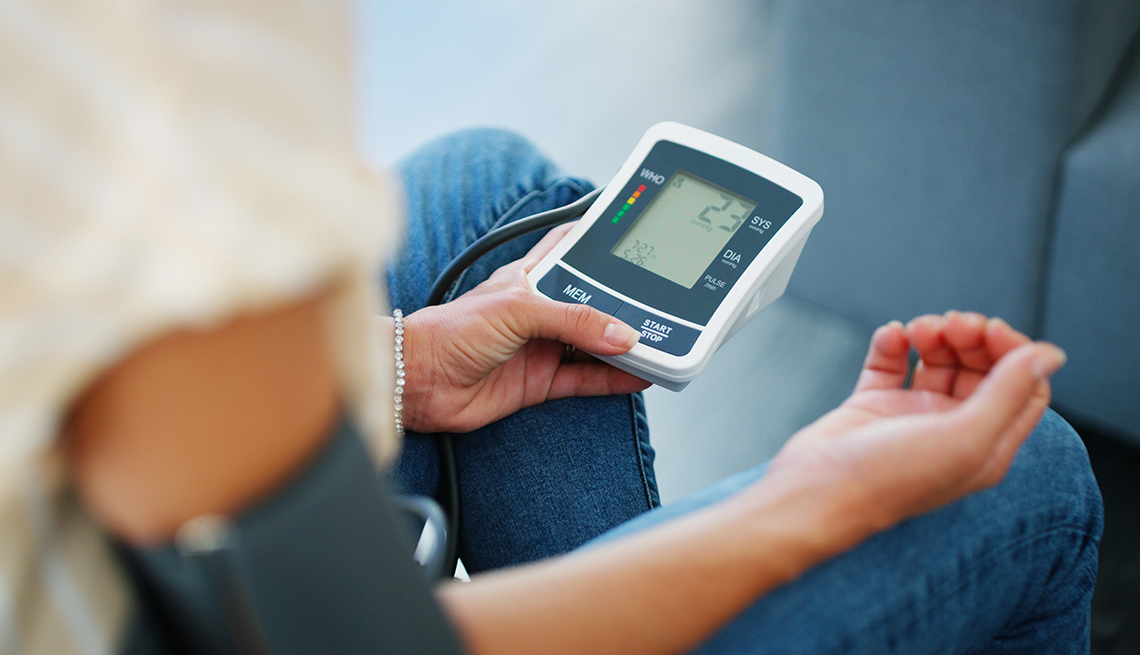Do you really have high blood pressure?
Do you really have high blood pressure?"
- Select a language for the TTS:
- UK English Female
- UK English Male
- US English Female
- US English Male
- Australian Female
- Australian Male
- Language selected: (auto detect) - EN
Play all audios:
If your office numbers are indeed high, ask your doctor about a home blood pressure monitor. These easy-to-use devices allow you to test your own blood pressure at various times during the
day, which can help your doctor rule out both white coat hypertension and masked hypertension. In some cases, doctors recommend ambulatory blood pressure testing, using a device that
automatically takes readings of blood pressure over a 24-hour period. Ambulatory testing can identify people whose pressure doesn't fall during the night, as it should. This phenomenon,
called "non-dipping," becomes more common as people age and has been shown to increase cardiovascular and stroke risk. WHAT SHOULD MY NUMBERS BE? High blood pressure in older
people is very different from the condition in middle age. "When people develop high blood pressure in middle age, the problem is typically elevated diastolic pressure, which is
indicated by the lower number," says Izzo. Ideally, the goal is to bring the numbers down close to a normal reading of 120/80. Once you hit age 60, though, it's the upper number —
the systolic pressure — that can really climb, causing concern. Systolic hypertension occurs when the arteries close to the heart begin to stiffen, making them less responsive to blood flow.
"In a sense, you have almost two forms of hypertension," Logan says. "Up until about 10 years ago, doctors only paid attention to diastolic hypertension. Now we know
it's really systolic hypertension that matters in older people." Further, many older people develop a condition called wide pulse pressure, in which diastolic pressure drops even
as systolic pressure climbs. The widening gap between the upper and lower numbers has been shown to be an independent risk factor for heart disease and stroke. Up until about 10 years ago,
doctors only paid attention to diastolic hypertension. Now we know it's really systolic hypertension that matters in older people. —Dr. Alexander G. Logan, a hypertension expert at
Mount Sinai Hospital in Toronto It also poses a tricky challenge for doctors. Drugs that lower systolic blood pressure typically bring down diastolic blood pressure, too. If that number is
already low, medications can prove risky. DO I REALLY NEED MEDICATION? Doctors need to tread carefully when treating older adults for hypertension, explains Logan. "Chronological age is
less important than overall health," he says. "I'd treat a very healthy 80-year-old as I would any [middle-aged] hypertensive. But in many older people, the target needs to
be carefully adjusted to avoid complications." High blood pressure increases the risk of heart attack and stroke, but very low blood pressure is dangerous, too, he points out.
Abnormally low diastolic pressure, for instance, means not enough blood is flowing back to the heart. That can deprive the heart of oxygen, causing it to enlarge, and can rob the brain of
blood. In someone with a wide pulse pressure, getting systolic pressure down without driving diastolic pressure too low can become a real balancing act. "Let's say a patient has
160/60," says Dr. Howard S. Weintraub, associate professor of medicine and director of the Center for the Prevention of Cardiovascular Disease at New York University Langone Medical
Center. "You can't go any further in those individuals or you may see unwanted consequences of low diastolic blood pressure." Doctors also have to be cautious about treating
people who are hypertensive but have transient low blood pressure when they stand. Bringing overall blood pressure down may increase the danger of falls. Despite the challenges of treating
hypertension in older patients, researchers emphasize the importance of controlling high blood pressure.
Trending News
Islands: origin of the canariesAccess through your institution Buy or subscribe This is a preview of subscription content, access via your institution ...
Safeguarding customer data programmeImpact assessment SAFEGUARDING CUSTOMER DATA PROGRAMME This is HM Revenue and Customs' initial equality impact asse...
Radio caustics from localized interstellar medium plasma structuresABSTRACT In a study of, 36 extragalactic radio sources observed over 7 years with the Green Bank interferometer at 2.7 G...
150 men take dip in ganga to get 'rid of toxic feminism'Last week, 150 men from various parts of the country took a dip in Ganga to get 'rid of toxic feminism'. Accor...
Second drugmaker will reduce insulin pricesMemorial Day Sale! Join AARP for just $11 per year with a 5-year membership Join now and get a FREE gift. Expires 6/4 G...
Latests News
Do you really have high blood pressure?If your office numbers are indeed high, ask your doctor about a home blood pressure monitor. These easy-to-use devices a...
Ryan reynolds films his colonoscopy to raise cancer awareness, says 'it can save your life' | watchRYAN REYNOLDS FILMED HIS COLONOSCOPY AND SHARED THE VIDEO ON SOCIAL MEDIA IN ORDER TO RAISE AWARENESS ABOUT COLON CANCER...
Nova | human nature | season 47 | episode 11♪ ♪ ♪ ♪ FYODOR URNOV: Mother Nature gave us something that's richer than our imagination. FRANCISCO MOJICA: We saw ...
Bone morphogenetic protein type ib receptor is progressively expressed in malignant glioma tumoursABSTRACT The distribution of bone morphogenetic protein (BMP) type I receptors and the activin type I receptor (ActR-I) ...
Defending 'Mother' - Los Angeles TimesIn response to the query about “My Mother, the Car” (TV Times, Just Asking, April 18), I would like to offer some words ...
